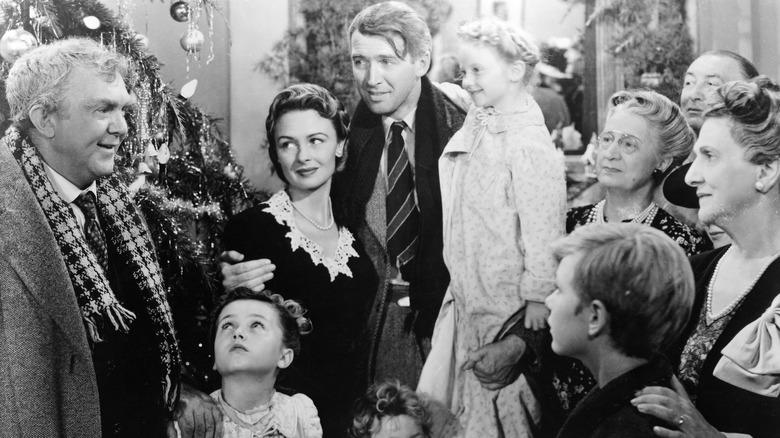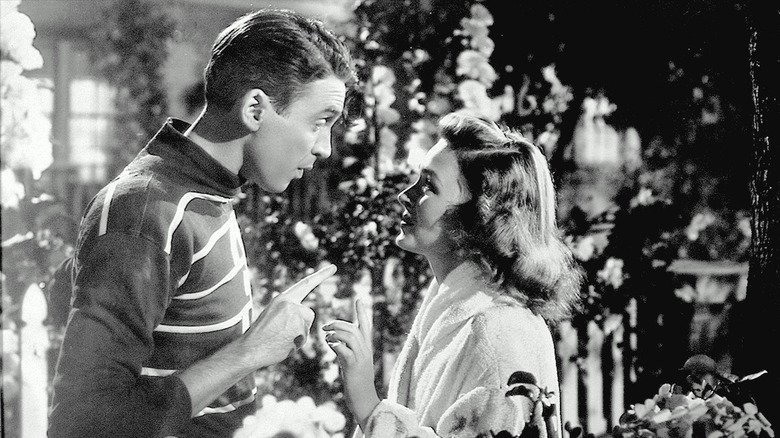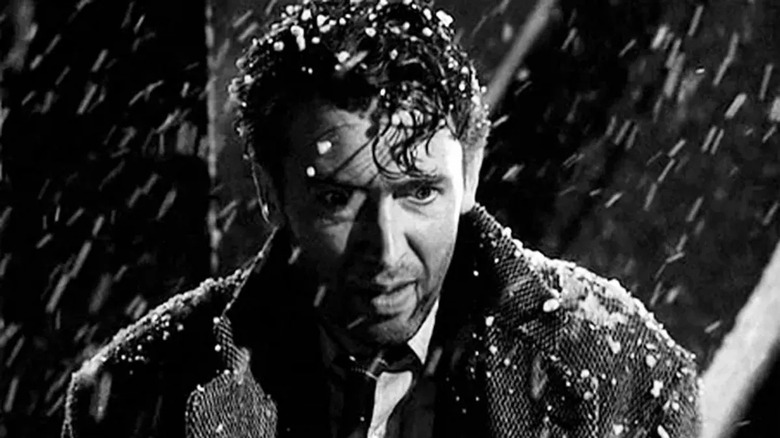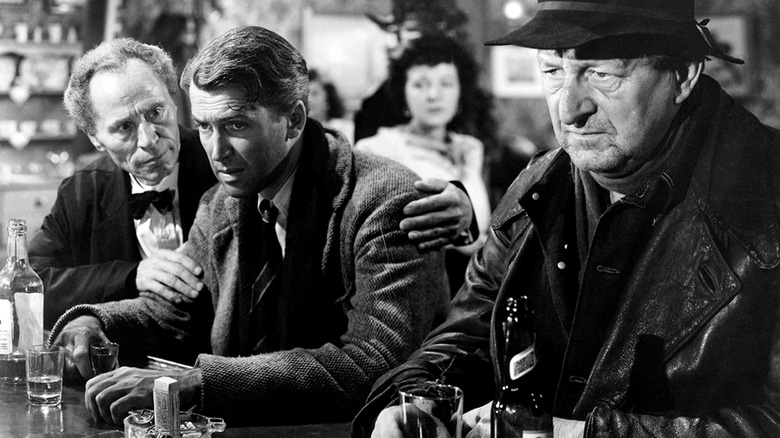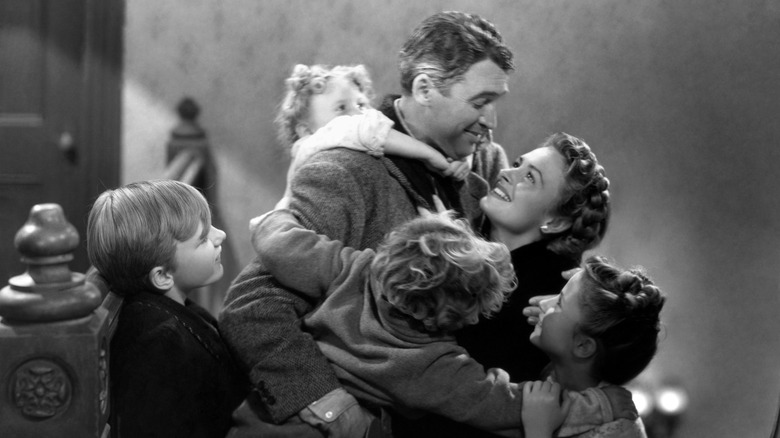How Public Domain Saved James Stewart's Favorite Film Performance
Several years ago, I held a screening of "It's a Wonderful Life" in my local pub just before Christmas. It's not a festive staple here in the Czech Republic, and a good few people in the audience didn't know anything about it. Toward the end, as George Bailey (James Stewart) is really going through the wringer, some were getting visibly bummed out by it. One friend got up to leave. "I need to get up early and this is kind of depressing," he said.
I never thought about it that way before because I grew up with the film and only saw it as a feel-good classic. The screening made me realize it's only feel-good if you make it all the way to the end, and it's pretty grueling before the cathartic singalong and talk of angels getting their wings. Director Frank Capra isn't afraid to go to dark places, crushing Bailey's spirit in order to lift him up again. Like all the best protagonists in Christmas stories, he must undergo a change of heart before he can appreciate his true riches: his family, friends, and home.
Much of how successfully this plays out depended on Stewart in one of his finest roles as Bailey. I'm in awe of some of the stuff he pulls off in this movie, and it ranks as one of the greatest performances of the Hollywood Golden Age. It was Stewart's favorite performance, too (via Roger Ebert). Yet if it weren't for a little clerical error, the film might have faded into obscurity altogether.
So what happens in It's a Wonderful Life again?
"It's a Wonderful Life" opens in outer space as two entities discuss the plight of George Bailey (James Stewart), a man who is preparing to die by suicide on Christmas Eve. They summon Clarence, a bumbling angel who hasn't received his wings yet, to learn everything he can about the man and help him find his way again.
Cue flashback: Now we're in the cozy town of Bedford Falls, where we meet George as a 12-year-old and as a grown-up. We see what a saint he is; he's good-natured and selfless, but he harbors ambitions to go out and see the world. Unfortunately for him, circumstances and his own conscience combine to ensure he never sets foot outside his hometown.
George frequently sacrifices himself for the good of others, like when he loses his hearing in one ear saving his kid brother from an icy death. As an adult just about to set out on his travels before going to college, he's left stuck holding the fort at the family-run Building and Loan when his father suddenly passes away, preventing it from falling into the hands of the grasping Mr. Potter (Lionel Barrymore).
George also gives his college fund to his younger brother on the understanding that, when Harry graduates, it will be George's turn. But Harry returns married with a plum job offer from his father-in-law, leaving George marooned indefinitely. In the meantime, George has married his childhood sweetheart, Mary (Donna Reed), and started a family.
Then on Christmas Eve, forgetful Uncle Billy (Thomas Mitchell) misplaces a wedge of cash just as the bank examiner arrives to go over the books, threatening bankruptcy. Bitter and desperate, George gets wasted and contemplates suicide. Clarence shows up just in time.
One of James Stewart's greatest roles
Thanks largely to his prewar performances, James Stewart gained a reputation as an aw-shucks everyman, a persona he gradually counteracted with a series of darker roles such as his riveting work for Alfred Hitchcock on "Rear Window" and "Vertigo." His performance as George Bailey falls neatly between the two. Early in the film, George seems the paragon of goodness, an upstanding young man who is genial, intelligent, kindhearted, and selfless to a fault.
Gradually, as life gets its hooks into him and his dreams suffer one setback after another, George's good nature curdles. Resentment sets in, though at first he fights it. One of my favorite moments is when George meets Harry and his new bride off the train, having waited four years for his brother to take over the bank so he can go to college. I love the way the camera stays on George when he realizes he's going to get stuck again, his face clouding over and his mind racing through the angles, before he puts on his usual jovial front.
Stewart isn't afraid to cut loose with the darker elements of the story as George becomes increasingly angry and embittered, ranting at his wife and kids. There's a stunning moment as George breaks down in tears, offering a desperate prayer as he thinks he's completely out of options. It's a magnificent performance from Stewart throughout, and George's journey into despair makes the final scene one of the most joyous and uplifting in cinema history.
It's a Wonderful Life flops
Frank Capra, who had worked with James Stewart on "You Can't Take It with You" and "Mr. Smith Goes to Washington," was sure he was the right man for the challenging role of George Bailey. As Capra wrote in "The Name Above the Title: An Autobiography" (via TVTropes.org):
"Of all actors' roles I believe the most difficult is the role of a Good Sam who doesn't know that he is a Good Sam. I knew one man who could play it ... James Stewart."
Stewart was all in from the moment Capra first pitched him the story. As Stewart told Guideposts:
"I jumped up. 'Frank, if you want to do a picture about a guy who jumps off a bridge and an angel named Clarence who hasn't won his wings yet coming down to save him, well, I'm your man!'"
Stewart was 100% committed to the film and Capra was hopeful about its prospects. Stewart continued:
"Frank talked enthusiastically about the picture. He felt that the film and actors would be up for Academy Awards. Both of us wanted it to win, not only because we believed in its message, but also for the reassurance we needed in this time of starting over."
Despite the director and his star's optimism, the film received some sniffy reviews from critics and performed poorly at the box office, making the studio a loss. The film was still nominated for five Academy Awards including Picture, Director, and Actor, but won none, taking home the consolation prize of a Technical Achievement Award.
To add insult to injury, the FBI issued a memo decrying the film as Communist propaganda, taking exception to the way the avaricious baddie, Mr. Potter, was portrayed.
A fortunate lapse of copyright
After such a middling reception, poor box office returns, and getting thoroughly trounced by "The Best Years of Our Lives" at the Oscars, "It's a Wonderful Life" may never have become the beloved Christmas classic it is today without a fortunate lapse of copyright.
When it was time to file an extension for copyright protection in 1974, a clerical error prevented the copyright holder from renewing the paperwork. As a result, "It's a Wonderful Life" fell into the public domain, meaning TV networks could show it without paying royalties. And show it they did, over and over again, every Christmas. Remember that scene in "Gremlins" where "Wonderful Life" is just kind of on in the background? That was pretty much how it was every Christmas when I was growing up. It was part of the tradition.
A court ruling in the early '90s involving another Stewart classic, "Rear Window," set things in motion for "It's a Wonderful Life" to fall back under copyright protection (via Plagiarism Today). The court declared that while the film might have entered the public domain, the source story and music had not. This encouraged Republic Pictures, owner of the story "Wonderful Life" was based on, to seize control of the film.
By that stage, "It's a Wonderful Life" had become part of the fabric of the holiday season for millions. If by some miracle you haven't seen it before, just make sure you don't bail 10 minutes before the end.
